About ActiveCare Physical Therapy®
The Best Physical Therapists in NYC
-
Our therapists are licensed in New York State and active members in the American Physical Therapy Association. We have advanced training in joint mobilization and myofascial release techniques.
-
We are dedicated practitioners with a passion for the profession and a comprehensive, holistic approach to treatment and healing. We treat each patient as an individual and treat the whole person, with a plan of care designed to meet the patient’s set goals for health, functionality and a return to work, tasks and activities. We network with a team of physicians, chiropractors, acupuncturists and massage therapists in order to provide guidance to other modalities that may be effective in the patients’ care. We also offer superior Telehealth services for physical therapy.
-
Physical Therapist and owner Dr. Karena Wu PT, DPT, OCS is a graduate of the Program in Physical Therapy at Columbia University and is affiliated with several healthcare organizations in New York City. She is certified as a Strength and Conditioning Specialist, Kinesio Taping Practitioner and Pilates Instructor, and uses SpiderTech Taping. She is also a Certified Orthopedic Manual Therapist, Strength and Conditioning Specialist, Graston Technique Specialist and Pilates Instructor. She holds LSVT BIG, FMS and SFMA Level 1 certifications as well. Dr. Wu also specializes in vertigo and temporomandibular joint disorders.
-
ActiveCare is primarily an out-of-network facility. We accept all insurance with out-of-network benefits and file for most major insurance plans. We work with all prospective patients to create workable payment plans regardless of insurance coverage.
-
ActiveCare accepts Medicare, No-Fault and Workers’ Compensation patients depending on schedule availability.
-
ActiveCare’s administrators provide seamless and efficient concierge-style client service to all of our patients. And the whole ActiveCare team makes sure your time with us is a beneficial, productive and enjoyable experience.
Quick Links
Manual Therapy Bursitis Plantar Fascitis Meniscus Tears Labral Tears Kinesiology Taping Pilates Rehab
Visit Our Main Website:
www.ActiveCarePhysicalTherapy.com
Blog Posts Are Below:
Category Archives: Best physical therapist for achilles tendonitis
Love Wearing Heels? 3 Options That Won’t Destroy Your Body
By Karena Wu, as published in MindBodyGreen
 There is such a thing as love at first sight.
There is such a thing as love at first sight.
Like the first time you saw your now-favorite shoes on the shelf at a store: that whirlwind of ecstasy you felt at having finally found your ideal sole mate. Hearts melt for beautifully crafted heels.
The popular shoes are an iconic symbol for power and sexuality. Stilettos, boots, pumps, wedges … as long as there’s added height, the inner lift will be there, and a more confident you will emerge. Alluring yes, but time for the bad news: one of these days, those heels will walk all over you. As euphoric as leg-lengtheners can be, they come with a painful price.
As a physical therapist, I realize heel lovers are becoming too attached to their feisty footwear, completely disregarding their pain probability. It’s become my mission to educate women on the dangers of heels and eliminate their pain as much as possible.
My hope is you’ll read these six potential high heel issues and change your thoughts on sky high shoes:
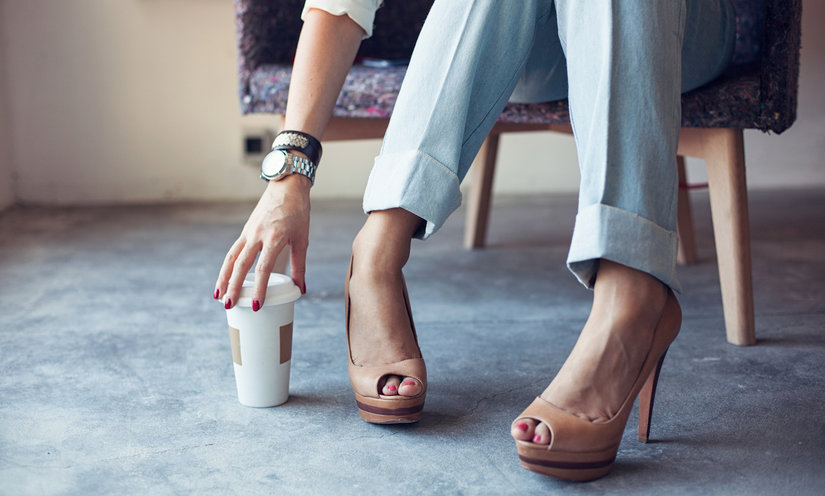
1. Achy ankles
When wearing heels, your ankles are vulnerable. They’re not aligned in the most stable position, meaning there’s more movement in the joint. You might as well be auditioning for “Bambi On Ice” while you totter around on heels — that’s how unstable your ankles are.
Platform heels in particular reduce control in the forefoot. This means that movements aren’t as accurate or stable, inevitably leading to more stumbles and falls. Runway models … how do you do it?
2. Unlucky ligaments
There are three ligaments on the outside of your ankle versus five on the inside. This means that even on a level, flat surface, the outer ankle is far more vulnerable and prone to giving out. Now add in the four-plus inches of a skinny heel at an improbable angle … those ligaments are in danger.
3. Crying calves
Adding calf raises to your workout routine is a great way to strengthen your lower leg, but when your calves are permanently raised throughout the day (the position they’re in while wearing heels), they’ll start crying out. Wearing heels leaves our calves in a shortened position, causing the muscle to tighten more and for longer than they should.
4. Cramp crisis
The combination of tight muscles, tight heel cords and loose tendons in the front of the foot means more instability and irritation. If you wear heels, you’re probably all too familiar with charley horses in your legs and foot cramps.
5. Toe troubles
Even though there’s less weight on the forefoot while wearing heels (because of that aforementioned shortened calf), there’s still pressure that can lead to jamming of the toes (in closed-toe heels) or slippage of the toes (in opened-toe heels).
6. Unstable heels
When you walk in regular, flat shoes, your heel hits the pavement first, giving you support and stability. In high shoes your “heel” alone can’t support you because it has such a small surface area, so the rest of your foot has to compensate, often messing up the natural stride and rhythm of your walk.
Teetering in high heels limits natural strides — with more tension all around, the reduced stride length can lead to stiff knees and hips, shortened muscles, tight calves and plantar fascia.
So what’s a heel loving fool to do? Well, I know you don’t want to give up those lovely lengthening shoes altogether, so here are three shoe types that can give you a lift without all the pain:
- Wedge heels: They have a larger surface area, and more support and stability for foot/shoe contact with the ground.
- Platform heels: Platforms that are reasonably high (not five-plus inches!) allow your foot to be less plantar flexed (toes down) because of the raised toe bed. There’s also less weight in the ball of the foot because it’s more evenly distributed throughout the foot.
- Heels with ankle straps: The shoe stays on comfortably, so you don’t have to put in extra effort for balance.
Click here to read the original article, and to book an appointment, visit www.activecarephysicaltherapy.com.
Photo Credit: Stocksy
Physical therapy for Achilles Pain
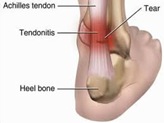 Injury to the Achilles tendon can produce pain located in the back of the leg near the heel. The Achilles tendon connects the heel bone to the calf muscles.
Injury to the Achilles tendon can produce pain located in the back of the leg near the heel. The Achilles tendon connects the heel bone to the calf muscles.
This tendon is the primary muscle used while walking, running, and jumping and is prone to inflammation due to degeneration and overuse. Inflammation in the Achilles tendon can lead to swelling, irritation of the area, and pain for the patient as it is the body’s largest tendon.
Physical Therapy For Achilles Tendon Pain
Types of Achilles Tendinitis
There are two types of Achilles inflammation, separated by the area of the tendon that becomes inflamed.
Noninsertional Achilles tendinitis (inflammation) occurs in the middle of the tendon where muscle fibers have begun to break down. This gradual degradation occurs primarily from the tendon’s overuse, making noninsertional Achilles tendinitis a commonly seen injury for active youth.
Insertional Achilles tendinitis occurs in the lower part of the heel, where the tendon meets and attaches (inserts) inside the bone of the heel.
In both insertional and noninsertional tendinitis, the damaged Achilles tendon fibers have the potential to calcify (harden) leading to further pain felt in the heel. Bone spurs, which are extra growth of bone that form into jutting pieces, may also form. Bone spurs are seen more commonly with insertional Achilles tendinitis, mainly due to inflammation occurring in the heel bone. Insertional Achilles tendinitis can occur in any patient regardless of their activity level.
PT For Achilles Tendinitis
Physician Evaluation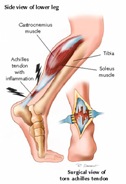
After examining what symptoms presented by the patient, the physician will physically examine the foot and ankle. During examination, the physician will check for swelling on the Achilles tendon and check for a thickening or enlargement of the tendon. Bone spurs will also be examined for. The physician will make note of where pain is indicated, checking primarily the middle of the tendon and the back of the heel. The current range of motion for the ankle will also be taken, with special attention paid to any reduction in the normal range of motion.
Best PT for Achilles Pain
Other symptoms of Achilles Pain may include:
• Pain and stiffness of the tendon
• Intense pain after exercise or exertion
• Swelling that increases throughout the say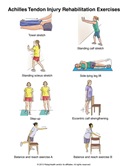
A “pop” in the heel or back of calf may indicate a rupture of the Achilles tendon and should be immediately be seen by a doctor.
Treatment for Achilles Pain
Although it seems more effective with noninsertational tendinitis, patients have found success in the elimination of Achilles pain symptoms with physical therapy. Innovative studies on new therapy techniques have been conducted by the Centre for Sports and Exercise Medicine, Queen Mary University of London, and show great promise in a full recovery of acute and chronic Achilles Tendinopathy (AT) and associated Achilles pain.
It is crucial to correctly attend to an injury with a proper treatment and physical therapy plan. Scientific evidence now supports the theory that what is many times considered an “Acute Tendinopathy” is actually an improperly healed chronic injury without histonic or biochemical inflammation that could have lifelong implications and increase in severity.
If you are experiencing Achilles pain, please contact ActveCare Physical Therapy.
What is Achilles tendonitis?
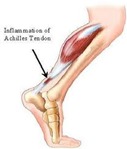 Achilles tendonitis refers to pain and inflammation in the tendon just above the back of the heel. Achilles tendonitis is considered an overuse injury. It is most common in athletes, and those who place repeated stress on the Achilles tendon. This frequently occurs with prolonged running, walking, and jumping maneuvers.
Achilles tendonitis refers to pain and inflammation in the tendon just above the back of the heel. Achilles tendonitis is considered an overuse injury. It is most common in athletes, and those who place repeated stress on the Achilles tendon. This frequently occurs with prolonged running, walking, and jumping maneuvers.
Because this area of the body does not have a good blood supply, Achilles tendonitis can persist for long periods of time. In an attempt to repair the small “micro tears” that have occurred in the Achilles tendon, the body creates new blood vessels and small nerve branches in the injured area. These new blood vessels and nerves are thought to be the source of pain.
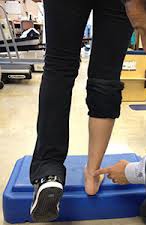 Treatment for Achilles tendonitis is aimed at relieving pain while also strengthening and supporting the Achilles tendon, ankle, and lower leg muscles. Rest, ice, and compression are critical components of care. Many patients with Achilles tendonitis find great improvement and relief from symptoms with a combination of moderate compression, supportive elastic bandages, and heel pads. In addition, manual therapies may help bring relief to the strained Achilles tendon itself, as well as address tensions in the foot, ankle, and calf that may be contributing to the problem. Specific targeted exercises can stabilize and strengthen the Achilles tendon, allowing it to be more resilient with future activity.
Treatment for Achilles tendonitis is aimed at relieving pain while also strengthening and supporting the Achilles tendon, ankle, and lower leg muscles. Rest, ice, and compression are critical components of care. Many patients with Achilles tendonitis find great improvement and relief from symptoms with a combination of moderate compression, supportive elastic bandages, and heel pads. In addition, manual therapies may help bring relief to the strained Achilles tendon itself, as well as address tensions in the foot, ankle, and calf that may be contributing to the problem. Specific targeted exercises can stabilize and strengthen the Achilles tendon, allowing it to be more resilient with future activity.
 ActiveCare Physical Therapy, PC
ActiveCare Physical Therapy, PC
29 West 38th Street
Suite 601
New York, NY 10018

